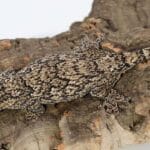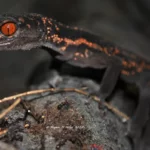The satanic leaf-tailed gecko (Uroplatus phantasticus)—a name that conjures images of mythical beasts—is, in reality, a small, unassuming reptile endemic to the rainforests of Madagascar. Its moniker, however, is not entirely undeserved. With a leaf-shaped tail, devilish horns above its eyes, and cryptic coloration, this gecko embodies a bizarre beauty that bewitches herpetologists and nature enthusiasts alike. This article delves into the world of this enigmatic creature, exploring its taxonomy, adaptations, habitat, behavior, conservation status, and the intricacies of captive care.
Unveiling the Master of Disguise
The satanic leaf-tailed gecko is a master of camouflage, a trait crucial for its survival in the predator-rich environment of Madagascar. Its most striking feature, from which it derives its common name, is undoubtedly its tail. Flattened, notched, and often exhibiting vein-like patterns, the tail mimics a decaying leaf with astonishing accuracy. This illusion is further enhanced by skin flaps along the gecko’s body, resembling the ragged edges of foliage, and a color palette ranging from mottled browns and tans to vibrant reddish hues. This masterful disguise allows it to blend seamlessly into the rainforest’s tapestry of leaves, becoming virtually invisible to both predators and unsuspecting prey.
A Closer Look at Uroplatus phantasticus
Taxonomy and Nomenclature
The satanic leaf-tailed gecko, scientifically classified as Uroplatus phantasticus, belongs to the family Gekkonidae. The genus name, Uroplatus, derives from the Greek words “oura” (tail) and “platys” (flat), a fitting description of its unique appendage. The species name, phantasticus, translates from Latin as “imaginary” or “illusory,” a testament to its remarkable camouflage, described as “mythical” by George Albert Boulenger upon its discovery in 1888. Other common names include the eyelash leaf-tailed gecko, referencing the dermal spines projecting around its eyes, and the phantastic leaf-tailed gecko.
Physical Adaptations: A Symphony of Deception
Beyond its remarkable tail, the satanic leaf-tailed gecko possesses a suite of adaptations that contribute to its cryptic lifestyle. Measuring up to 90mm (3.5 inches) in total length, this small reptile boasts large, forward-facing eyes, essential for navigating the dimly lit rainforest understory and ambushing its insect prey. Its arboreal existence is facilitated by adhesive scales under its fingers and toes, providing exceptional grip, and strong, curved claws perfectly suited for clinging to branches and navigating the complex three-dimensional world of the rainforest canopy.
Madagascar: A Haven and a Threat
The satanic leaf-tailed gecko is endemic to Madagascar, found nowhere else on Earth. It inhabits the northern and central tropical forests of the island, a biodiversity hotspot teeming with unique flora and fauna. This arboreal specialist spends its days motionless amongst the foliage, practically invisible to the casual observer, only stirring at night to hunt. Its preferred prey consists primarily of insects, which it ambushes with surprising speed and agility.
Conservation: A Call to Action
Like many of Madagascar’s unique inhabitants, the satanic leaf-tailed gecko faces mounting pressures from habitat loss due to deforestation and illegal collection for the pet trade. Its unusual appearance makes it a highly sought-after species among reptile collectors, driving unsustainable removal from its natural habitat. Thankfully, the species is listed under Appendix II of the Convention on International Trade in Endangered Species (CITES), which regulates its trade to prevent overexploitation. However, continued habitat preservation and stricter enforcement against illegal poaching are vital for its long-term survival. Several protected areas in Madagascar, such as the Masoala National Park and Ranomafana National Park, provide sanctuary for this unique species, though ongoing research is needed to fully assess its population status and the effectiveness of these conservation measures.
Captive Care: Recreating the Rainforest
The satanic leaf-tailed gecko has become increasingly popular in the reptile trade, often kept in breeding pairs or trios. However, providing appropriate care requires a deep understanding of its specific needs and a commitment to replicating its natural environment as closely as possible.
The Ideal Enclosure
A tall enclosure is paramount, mimicking the gecko’s arboreal lifestyle. Furnishing the enclosure with an array of branches, cork bark, and foliage provides essential climbing opportunities and hiding places, contributing to the gecko’s overall well-being and allowing it to exhibit natural behaviors. Maintaining a humidity level between 70-80% is crucial, achieved through regular misting with dechlorinated water and a moisture-retaining substrate such as coconut fiber or sphagnum moss. A temperature gradient between 72-80°F (22-27°C) during the day, with a slight drop at night, mimics the natural temperature fluctuations of its rainforest home. While the necessity of UVB lighting is debated, providing a low-level UVB source may offer benefits by replicating natural sunlight and supporting vitamin D3 synthesis.
Nutritional Needs
The satanic leaf-tailed gecko’s diet in captivity should mirror its insectivorous habits in the wild. Crickets and moths serve as suitable staple insects, supplemented occasionally with other appropriately sized insects like roaches or mealworms. Gut-loading the insects with a nutritious diet before offering them to the gecko ensures optimal nutrient transfer. Dusting the insects with calcium and vitamin D3 supplements is essential to prevent metabolic bone disease, a common ailment in captive reptiles. These geckos typically hydrate by licking water droplets from leaves and other surfaces after misting, hence regular misting serves a dual purpose of maintaining humidity and providing a water source.
Handling and Temperament
Satanic leaf-tailed geckos are shy and nocturnal creatures, easily stressed by excessive handling. They should be handled only when absolutely necessary, such as for health checks or enclosure cleaning. Their tails are delicate and prone to damage, so extreme caution must be exercised during handling. If a gecko does drop its tail as a defense mechanism, it will regenerate, but the new tail will not appear exactly the same. Respecting their need for seclusion and avoiding disturbance during daylight hours is essential for their well-being.
Beyond the Basics: Ongoing Research
While our understanding of the satanic leaf-tailed gecko has grown significantly, research continues to uncover new insights into its biology, behavior, and specific needs. For example, there are ongoing investigations surrounding their social interactions in the wild, the subtle nuances of their communication, and the precise mechanisms that drive their remarkable camouflage. Exploring these areas will not only enhance our appreciation for this incredible creature but also inform more effective conservation strategies.
The Future of the Satanic Leaf-Tailed Gecko
The satanic leaf-tailed gecko, with its captivating camouflage and unique adaptations, stands as a testament to the incredible biodiversity of Madagascar’s rainforests. Its future, however, remains uncertain, threatened by habitat destruction and the pressures of the pet trade. By supporting conservation efforts, promoting responsible pet ownership, and continuing research, we can strive to ensure that this enigmatic creature continues to thrive for generations to come. You can learn more about other fascinating creatures like the raccoon oosik and the raccoon baculum to broaden your understanding of the animal kingdom.












